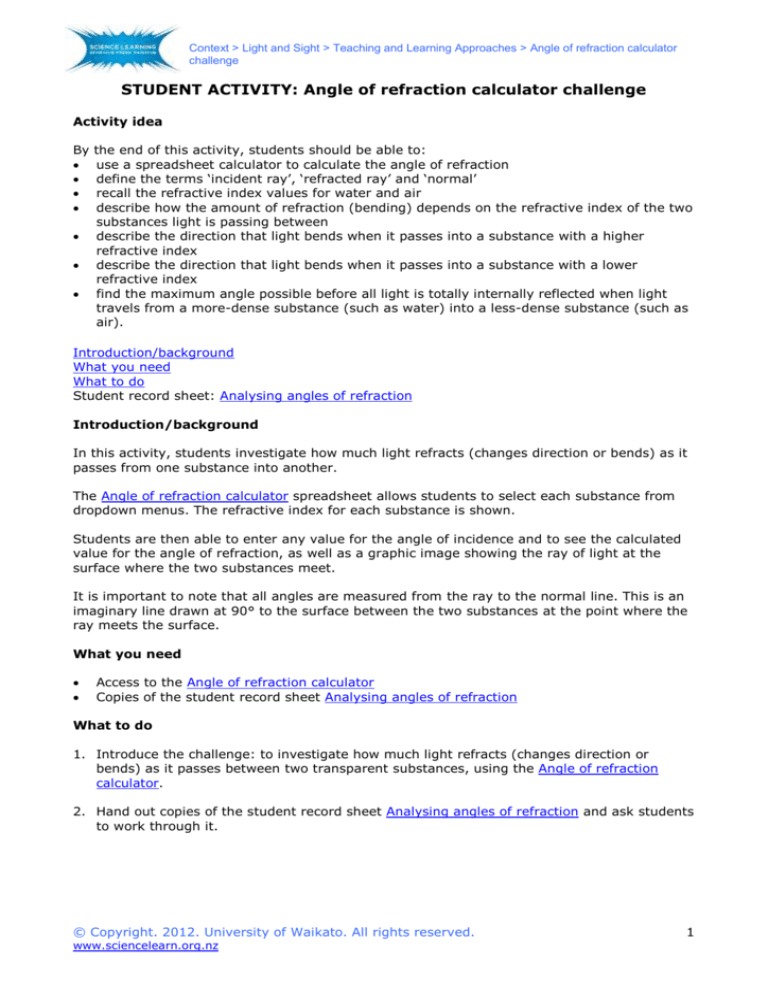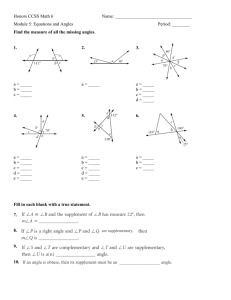
Context > Light and Sight > Teaching and Learning Approaches > Angle of refraction calculator
challenge
STUDENT ACTIVITY: Angle of refraction calculator challenge
Activity idea
By
the end of this activity, students should be able to:
use a spreadsheet calculator to calculate the angle of refraction
define the terms ‘incident ray’, ‘refracted ray’ and ‘normal’
recall the refractive index values for water and air
describe how the amount of refraction (bending) depends on the refractive index of the two
substances light is passing between
describe the direction that light bends when it passes into a substance with a higher
refractive index
describe the direction that light bends when it passes into a substance with a lower
refractive index
find the maximum angle possible before all light is totally internally reflected when light
travels from a more-dense substance (such as water) into a less-dense substance (such as
air).
Introduction/background
What you need
What to do
Student record sheet: Analysing angles of refraction
Introduction/background
In this activity, students investigate how much light refracts (changes direction or bends) as it
passes from one substance into another.
The Angle of refraction calculator spreadsheet allows students to select each substance from
dropdown menus. The refractive index for each substance is shown.
Students are then able to enter any value for the angle of incidence and to see the calculated
value for the angle of refraction, as well as a graphic image showing the ray of light at the
surface where the two substances meet.
It is important to note that all angles are measured from the ray to the normal line. This is an
imaginary line drawn at 90° to the surface between the two substances at the point where the
ray meets the surface.
What you need
Access to the Angle of refraction calculator
Copies of the student record sheet Analysing angles of refraction
What to do
1. Introduce the challenge: to investigate how much light refracts (changes direction or
bends) as it passes between two transparent substances, using the Angle of refraction
calculator.
2. Hand out copies of the student record sheet Analysing angles of refraction and ask students
to work through it.
© Copyright. 2012. University of Waikato. All rights reserved.
www.sciencelearn.org.nz
1
Context > Light and Sight > Teaching and Learning Approaches > Angle of refraction calculator
challenge
Analysing angles of refraction
You will investigate how much light refracts (changes direction or bends) as it passes between
two different substances. Use the Angle of refraction calculator to complete this investigation.
1. Light travelling from air into water.
Select air as your substance 1 using the dropdown arrow. Select water as your substance
2.
Refractive index of air = _____
Refractive index of water = ____
Complete the table to find out the angle of refraction when light enters the water at each of
the following angles.
Angle of incidence (degrees)
0
20
40
60
80
Angle of refraction (degrees)
Does the refracted ray move closer towards or further away from the normal line?
2. Light travelling from air into glass.
Select glass (acrylic) as substance 2 using the dropdown arrow.
Refractive index of glass = ____
Complete the table to find out the angle of refraction when light enters the glass at each of
the following angles.
Angle of incidence (degrees)
0
20
40
60
80
Angle of refraction (degrees)
3. Light travelling from air into diamond.
Select diamond as substance 2 using the dropdown arrow.
Refractive index of diamond = ____
Complete the table to find out the angle of refraction when light enters the diamond at
each of the following angles.
Angle of incidence (degrees)
0
20
40
60
80
Angle of refraction (degrees)
4. Which of the above substances (water, glass or diamond) makes light bend the most?
5. What does the refractive index show about how much light bends?
© Copyright. 2012. University of Waikato. All rights reserved.
www.sciencelearn.org.nz
2
Context > Light and Sight > Teaching and Learning Approaches > Angle of refraction calculator
challenge
6. Complete the following statements:
A more-dense substance like water has a lower / higher refractive index than air.
Whenever light enters a substance with a higher refractive index (more dense), it will bend
closer towards / further away from the normal line.
7. Use a protractor and ruler to show how much a ray of light bends as it enters a pool of
water at the angle shown.
All angles are measured from the ray to the normal line (as shown by the dashed line – this
is an imaginary line drawn at 90° to the surface at the point where the ray meets).
8. Light travelling from water into air.
Now select water as substance 1 using the dropdown arrow. Select air as substance 2.
Refractive index of water = _____
Refractive index of air = ____
Complete the table to find out the angle of refraction when light comes out of the water
and travels into the air for each of the following angles of incidence.
Angle of incidence (degrees)
0
20
40
60
80
Angle of refraction (degrees)
What is the maximum angle of incidence before no light is refracted and all of the light is
totally internally reflected back into the water (none of it comes out into air)?
Maximum angle of incidence = _____ degrees
© Copyright. 2012. University of Waikato. All rights reserved.
www.sciencelearn.org.nz
3
Context > Light and Sight > Teaching and Learning Approaches > Angle of refraction calculator
challenge
9. Light travelling from glass into air.
Select glass as substance 1 using the dropdown arrow.
Refractive index of glass = ____
Complete the table to find out the angle of refraction when light comes out of the glass and
travels into the air for each of the following angles.
Angle of incidence (degrees)
0
20
40
60
80
Angle of refraction (degrees)
What is the maximum angle of incidence before no light is refracted and all of the light is
totally internally reflected back into the glass (none of it comes out into air)?
Maximum angle of incidence = _____ degrees
10. Light travelling from diamond into air.
Select diamond as substance 1 using the dropdown arrow.
Refractive index of diamond = ____
Complete the table to find out the angle of refraction when light comes out of the diamond
and travels into the air for each of the following angles.
Angle of incidence (degrees)
0
20
40
60
80
Angle of refraction (degrees)
What is the maximum angle of incidence before no light is refracted and all of the light is
totally internally reflected back into the water (none of it comes out into air)?
Maximum angle of incidence = _____ degrees
11. Complete the following statements:
Whenever light travels from a more-dense substance like water into a less-dense substance
like air, it will bend closer towards / further away from the normal line.
The maximum angle that the incident ray can be is called the critical angle.
Whenever the angle of incidence is greater than the critical angle, the light will
t______________ i_______________ r_______________.
© Copyright. 2012. University of Waikato. All rights reserved.
www.sciencelearn.org.nz
4








